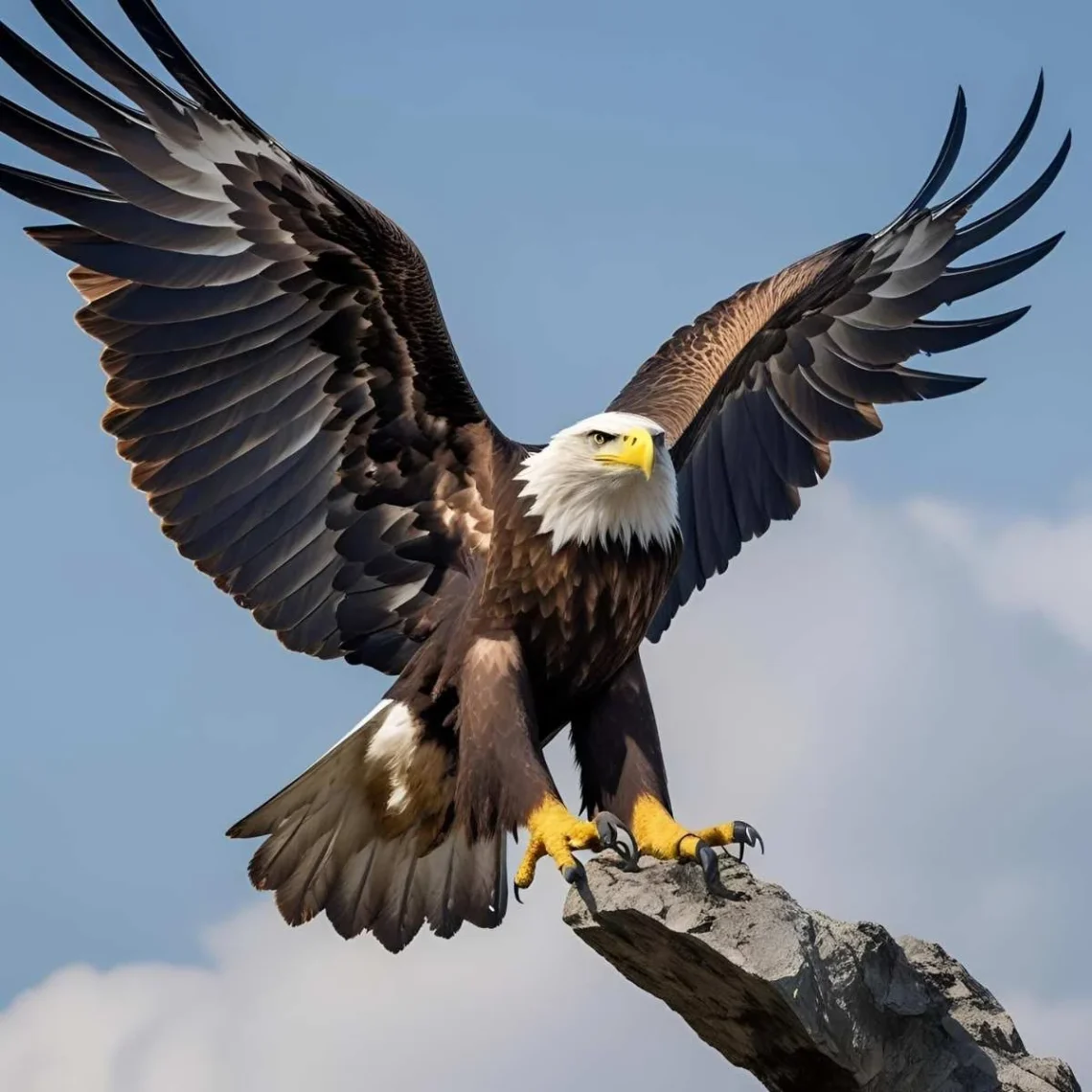Picture standing on a windswept cliff, watching an eagle soar above a rugged landscape. Its wings catch the sunlight, embodying freedom and power. Across cultures, the word for “eagle” evokes awe, symbolizing strength, vision, and courage.
Whether it’s called “águila” in a Spanish village or “ōkami” in a Japanese forest, this term unites humanity’s admiration for this majestic bird, shaped by unique cultural lenses.
Let’s embark on a global journey to explore how people name the eagle and what these words reveal about their traditions.
Reference Table: “Eagle” in Different Languages
| Language | Word/Phrase | Cultural/Linguistic Insight |
|---|---|---|
| French | Aigle | Rooted in Latin “aquila,” symbolizing nobility and strength. |
| Spanish | Águila | Linked to “aquila,” often tied to heraldry and power in Spain. |
| Italian | Aquila | Evokes Roman heritage, where eagles symbolized imperial might. |
| German | Adler | A term for large birds of prey, tied to Germanic folklore. |
| Mandarin | Yīng (鹰) | Represents strength and keen vision, revered in Chinese culture. |
| Hindi | Garuda | A mythical eagle-like bird, central to Hindu mythology. |
| Japanese | Ōkami (鷹) | Refers to hawks or eagles, symbolizing precision in samurai culture. |
| Korean | Dokkaebi (독수리) | Means “bald eagle,” tied to strength and freedom. |
| Arabic | Nisr (نسر) | Symbolizes power and high flight, used across 20+ countries. |
| Swahili | Tai | A concise term, reflecting the bird’s majesty in East Africa. |
| Zulu | Ukhozi | A revered symbol of courage and vision in South Africa. |
| Yoruba | Ìdì | Tied to spiritual strength, often used in Nigerian folklore. |
| Maori | Kārearea | Refers to the native falcon, a symbol of agility in New Zealand. |
| Hawaiian | ʻAeto | Evokes the spirit of aloha, tied to freedom and sky. |
| Cherokee | Wohali | A sacred bird, symbolizing spiritual connection and vision. |
European Languages: Eagles as Symbols of Power
European languages name the eagle with terms rooted in history and symbolism. For instance, in French, “aigle” comes from Latin “aquila,” evoking nobility, as seen in Napoleonic emblems. Meanwhile, Spanish uses “águila,” tied to heraldry and strength, often depicted in Spain’s coats of arms. Additionally, Italian’s “aquila” recalls the Roman Empire, where eagles symbolized imperial might, still revered in modern Italy. In German, “Adler” encompasses large birds of prey, linked to Germanic tales of courage. Thus, these terms reflect Europe’s view of eagles as emblems of power and prestige, from Roman legions to modern flags.
Asian Languages: Eagles in Myth and Majesty
Asia’s diverse languages offer rich terms for “eagle,” often tied to mythology and precision. For example, in Mandarin, “yīng” symbolizes strength and sharp vision, revered in Chinese art as a guardian of the skies. In Hindi, “garuda” refers to a mythical eagle-like bird, a divine mount in Hindu epics like the Mahabharata, embodying power and speed. Similarly, Japanese uses “ōkami” for hawks or eagles, linked to samurai ideals of precision and focus. In Korean, “dokkaebi” (bald eagle) evokes freedom, often depicted in modern media. Finally, Arabic’s “nisr,” used across over 20 countries like Egypt and Iraq, symbolizes high flight and dominance, rooted in poetic traditions. These terms highlight Asia’s blend of spiritual reverence and admiration for the eagle’s prowess.
African Languages: Eagles as Spiritual Guides
In African languages, “eagle” often carries spiritual and communal significance. For instance, Swahili, spoken in over 20 countries like Kenya and Tanzania, uses “tai,” a concise term reflecting the bird’s majesty in oral traditions. In Zulu, “ukhozi” is a symbol of courage in South Africa, often featured in proverbs about leadership. Similarly, Yoruba’s “ìdì” in Nigeria ties the eagle to spiritual strength, revered in folklore as a messenger of the gods. These terms, used in vibrant markets or village gatherings, emphasize the eagle’s role as a guide and protector across African cultures.
Indigenous & Island Languages: Eagles in Sacred Skies
Indigenous and island languages name the eagle with reverence for its spiritual role. For example, Maori in New Zealand uses “kārearea” for the native falcon, a symbol of agility and guardianship. In Hawaiian, “ʻaeto” evokes freedom, tied to the aloha spirit and the vast Pacific skies. Similarly, Cherokee’s “wohali” is a sacred bird, symbolizing vision and connection to the divine in Native American communities. In Samoan, terms like “aeto” reflect the Pacific’s communal reverence for birds of prey, often celebrated in oral histories. Across these cultures, from New Zealand to the Cherokee Nation, the eagle represents spiritual elevation and unity.
Cultural Insights: The Eagle’s Timeless Legacy
Words for “eagle” carry centuries of meaning. In ancient Rome, “aquila” was a military standard, symbolizing victory. In Hindu mythology, “garuda” is a divine protector, still revered in modern India. Moreover, in African traditions, eagles like “ukhozi” are spiritual messengers, tied to rituals of leadership. In Native American cultures, the eagle’s feathers are sacred, used in ceremonies to connect with the divine. These terms reflect the eagle’s role across civilizations, from symbols of conquest to spiritual guides, uniting humanity’s awe for this majestic creature.
Proverbs and Sayings: Wisdom of the Eagle
- French: “L’aigle ne chasse pas les mouches.” (The eagle doesn’t hunt flies.) – Highlights focus on worthy goals.
- Hindi: “Garuda ki nazar kabhi nahin chookti.” (Garuda’s sight never misses.) – Emphasizes sharp vision.
- Swahili: “Tai huruka juu, anaona mbali.” (The eagle flies high, sees far.) – Ties eagles to foresight.
- Japanese: “Ōkami wa sora no samurai.” (The eagle is the samurai of the sky.) – Reflects precision and honor.
- Yoruba: “Ìdì n’oluwosan ayé.” (The eagle is the healer of the world.) – Links eagles to spiritual power.
FAQs
Why do some words for “eagle” sound similar?
Shared linguistic roots, like Latin “aquila” in Romance languages, and cultural exchanges, like Arabic’s influence on Swahili, create similarities.
What’s the oldest term for “eagle”?
Latin “aquila” (circa 1st century BCE) is among the earliest, used in Roman military and later adopted in European languages.
How do cultures shape the term’s use?
In spiritual cultures (e.g., African, Indigenous), eagles symbolize divine connection, while in militaristic cultures (e.g., Roman), they represent power.
Conclusion
From “águila” in Spain to “tai” in Tanzania, the word for “eagle” soars as a global symbol of strength and vision. Each term, whether the mythical “garuda” in Hindi or the sacred “wohali” in Cherokee, reflects cultural values while celebrating the eagle’s universal majesty. Consequently, these words remind us that this bird inspires awe across all people, uniting us in admiration. How do you say “eagle” in your language, and what does it symbolize? Share your thoughts below—we’re eager to hear your story!






